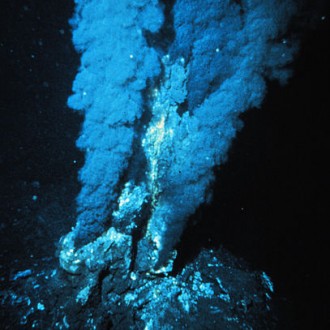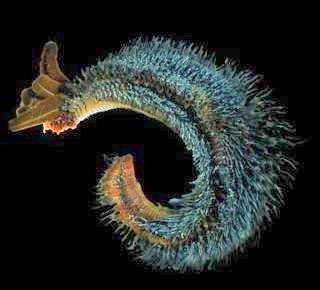
The black smokers of Galapagos…
The discovery of hydrothermal vents has revolutionised our view of life in the oceans.
When a team of geologists went to explore a temperature anomaly over the mid-oceanic spreading ridge to the northeast of the Galapagos Archipelago in 1977, they cannot have been prepared for what they were about to discover. Plumes of black, superheated and mineral-laden water billowing out of chimneys that projected up from the seafloor to the height of 10 storey buildings. At 2,550m deep and inside the world’s first deep-sea research submersible, Alvin, they were also the first humans to observe the thriving benthic community living around these impressive structures.
Such was the discovery of the first hydrothermal vents on Earth. Since then, over 500 other vent sites have been located, occurring along the deep-sea ridges that surround the tectonic plates of Earth’s crust. Vents expel water that often exceeds 350⁰C but due to the enormous pressure present at these depths it doesn’t boil. Rich in dissolved minerals from the crust, vent fluid cools rapidly due to the surrounding oceanic water, creating the dense black (or sometimes white) clouds that vents are so well known for.

The discovery of hydrothermal vents revolutionised our view of life in the oceans. It was previously believed that all life on Earth was ultimately reliant on energy that had originated via the process of photosynthesis. Most deep-sea species live in sparse, slow growing populations, making use of the small amount of organic matter that sinks down from the photic zone above. The abundance of animals that was observed living alongside these black smokers however was far too dense to be explained this way. It is now understood that instead of using sun-dependent photosynthesis to produce energy, vent communities rely on the process of chemosynthesis.
Deep-sea chemosynthetic bacteria are able to use the oxygen in seawater and the chemical compounds that are discharged from vents to create energy. Once this initial source of energy has been established, larger and more complex organisms can begin to harness it. Some vent species, such as amphipods, graze directly upon the dense mats of bacteria that form around the chimneys. Most species however harness the bacteria within their body in a symbiotic relationship. Some animals, such as the iconic tube worms, have evolved to become so dependent on this symbiotic relationship that they lack any gut, gaining all the energy that they require from the chemosynthetic bacteria inside them.
Invertebrates dominate the vent ecosystem, with tube worms and bivalve molluscs (e.g. clams) being the most common organisms. Tube worms, as their name suggest, live inside tubes attached to the walls of the hydrothermal vents and can grow to over two metres long. They have a scarlet crown of gills that extend out from the tube to absorb oxygen from the water and it was because of these features that the first site visited in Galapagos was named the Rose Garden.
Another interesting discovery from the depths of Galapagos was made by a team of French marine biologists in the 1980’s. The Pompeii worm, Alvinella pompejana, a type of bristle worm which lives on hydrothermal vents, is one of the most heat-tolerant species on the planet. The tail end of this tube-dwelling worm can be resting in water up to 80⁰C, whilst the head-end experiences a much cooler 22⁰C.
There is still much to be discovered about hydrothermal vents and the communities that rely upon them. Just last year a thriving community of a previously unknown vent squat lobster was discovered on a NERC-funded expedition. The squat lobsters have been nicknamed “Hoff crabs” due to the abundance of hair-like setae on their underside resembling the hairy chest of David Hasselhoff, and occur in great densities around vents in the Southern Ocean (see a video here).
Incredibly, it is also now believed that hydrothermal vents may exist on one of Jupiter’s moons and may have been present on Mars in the distant past. That such an incredible and diverse ecosystem remained undiscovered until 35 years ago is remarkable and one can’t help but think what else may lay undiscovered in the depths of our ocean.


